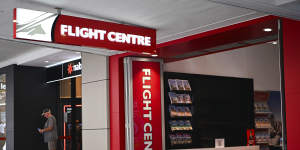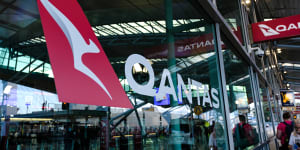The punters wanted more,and its share price tanked in response to their disappointment,trading down 8 per cent to $20.38 by mid-morning on Wednesday.

Flight Centre chief executive Graham Turner.Oscar Colman
Regardless of how much higher investors would have preferred the profit to have landed,the result was still impressive and a demonstration of our love affair with travel.
So investors can thank Australians re-engaging with the wanderlust they have traditionally been known for,coupled with the tail end of revenge travel.
illustrates clearly enough that travellers have been prepared to bite the bullet on fares that are still significantly above where they were pre-COVID and prioritise travel,even if they are curtailing the purchase of other non-discretionary goods and services.
More particularly,this result is further evidence of the divide between the strugglers and the financially comfortable cohorts that coexist in Australia.

Flight Centre posted a huge profit.Dan Peled
As ANZ chief executive Shane Elliott said in his now famous explanation for why the level of problem loans in its mortgage portfolio remained so low:“If you want a loan you have to be better-off,and essentially rich.”
The same goes for overseas travel,according to Flight Centre Travel’s chief executive,Graham Turner,who says that despite a cost of living crisis,a large community cohort has money and is prepared to spend it on holidays.
According to Turner,this travel brigade is typically aged around 50 or older and is not the group being confronted by the cost of buying meat at the supermarket.
These higher middle income people are less likely to have a large mortgage and more likely to have money in the bank that is attracting higher interest rates.
These people certainly register that prices have gone up,but they are not in crisis.
The rich buy houses and the rich travel overseas.
Turner also echoes comments made by Qantas that suggest people are prioritising travel.
“At a time when discretionary budgets are typically tightening,travel remains an outlier and a priority spend for many. We are seeing ongoing solid demand leading to our second-strongest start to a[financial] year in total transaction value terms[turnover],” he says.

Qantas and other airlines no longer have the tailwind from extremely high fares.Oscar Colman
But to put this into perspective,while Flight Centre’s earnings improvement was enormous,the 565 per cent gain is compared against a very lean profit period in the previous corresponding half.
Flight Centre is predicting a strong profit for the current half to June and for demand to remain strong as international airfares decline. It said international airfares had fallen by 13 per cent in the three months to December 2023 compared with the same period a year earlier. And Turner says he is expecting prices to fall another 9 per cent over the next six months.
The tail end of the 2022 calendar year is when airfares peaked.
He says the increased capacity coming on from airlines like Turkish Airlines,Singapore Airlines and Emirates will be a major driver of that.
For airlines such as Qantas,the demand for travel has resulted in strong profits,but didn’t match the bumper earnings it was making last year,as the company was forced to reinvest in customer service.
Qantas and other airlines no longer have the tailwind provided by extremely high fares and last year was their earnings sweet spot.
The January inflation figures released on Wednesday showed holiday travel and accommodation had fallen 7.1 per cent from January last year to January in 2024.
Just over a week ago,Air New Zealand warned its fortunes would reverse in the next six months as competition returned,corporate bookings remained soft and delivery of new planes stalled.
[Flight Centre’s Graham] Turner predicts that by 2025 airfares will be back to pre-COVID levels … bring it on.
Airlines and travel agents need lower prices to generate a greater thirst for travel,both leisure and business.
Certainly,the lower than expected inflation reading for January will provide hope that interest rates have peaked and will come down later this year,which might release a bit of cash to household budgets and free up some balance sheet space for travel.
Turner predicts that by 2025 airfares will be back to pre-COVID levels. I am sure I will be echoing the thoughts of the travelling public when I say:bring it on.
The Business Briefing newsletter delivers major stories,exclusive coverage and expert opinion..